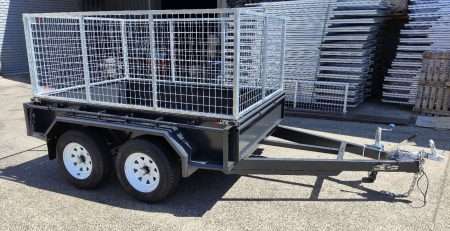
How To Reverse A Trailer – Ultimate Guide
Reversing a trailer is a skill that at first can seem daunting. Maneuvering an attached load in the opposite direction requires a keen understanding of how the trailer behaves in relation to your tow vehicle. Grasping the concept of pivot points is essential; they are the unseen fulcrum in the dance of backward motion. Coupled with this knowledge, correct hand positioning on the steering wheel is not merely a matter of comfort, but of control. It ensures the driver intuitively steers the trailer along the desired path. As we delve into the art of trailer reversal, remember that theory is only the beginning—the real prowess in maneuvering a trailer is nurtured through persistent practice of techniques like the S-method and pull-forward method. Let’s embark on this journey of mastering the reverse, an indispensable skill for trailer owners and enthusiasts alike.
Understanding Trailer Pivot Points
Mastering the Art of Reversing: How Trailer Pivot Points Make All the Difference
When it comes to towing a trailer, whether you’re hauling a boat to the lake, a horse to the barn, or supplies for a weekend camping trip, reversing can often be the most daunting part of the journey. One key aspect of mastering this skill is understanding how trailer pivot points affect the reversing maneuver. When you really get down to it, knowing where your pivot points are and how they work will turn the art of backing up into a smooth, almost effortless process.
The Basics of Trailer Pivot Points
First things first, what is a pivot point? Simply put, it’s the spot around which your trailer rotates when you’re making turns or reversing. On a basic two-wheel trailer, the pivot point is the axle. Understanding this helps determine how and when the trailer moves in relation to your towing vehicle.
When you reverse, the trailer pivot point becomes the axis of rotation. This is important because the direction in which you turn your vehicle’s steering wheel will determine how the trailer pivots around that axis. Turn the wheel to the right, and your trailer will swing to the left around its pivot point, and vice versa.
Step-by-Step Guide to Reversing with Pivot Points in Mind
- Straight Line Reversing: To start with a straight line, keep the wheel steady and reverse slowly. The trailer should follow the direction of the car. If you see the trailer starting to veer off to one side, gently correct by turning the wheel in the opposite direction of the drift.
- Making Adjustments: If the trailer needs to pivot around a corner or into a tight space, remember slow and steady wins the race. Small adjustments go a long way. If the angle becomes too sharp too quickly, the pivot point is overreacting to steering inputs. Ease up on the angle to straighten out.
- The Slight Delay: When reversing, your inputs to the steering wheel will have a delayed effect on the trailer. This is because the pivot point needs a moment to catch up with the direction of the car. Think of it as steering the rear end of the vehicle rather than the front.
- Using Your Mirrors: Always use your side mirrors to gauge the trailer’s position. The mirror on the side that the trailer is turning towards will show you the pivot point’s movement. Use this visual to determine if the pivot is aligned towards your desired path.
- Controlling Speed: The quicker you reverse, the more sensitive the pivot point becomes to your steering inputs, making control more difficult. Keep your speed down to maintain better control of the pivot point.
Final Thought
Getting the hang of reversing a trailer might seem intimidating at first, but once you’ve got the pivot points figured out, you’ll navigate backwards like a pro. Understanding how your trailer reacts and practicing will build your confidence and precision. There’s a distinct satisfaction in lining up your trailer perfectly by taming the pivot point to your will. No summary needed here – just go out there and give it a try!

Hand Positioning on the Steering Wheel
Fine-Tuning Your Grip: Hand Placement for Supreme Trailer Mastery
When you’ve hitched up a trailer to your vehicle, you’ve just entered a whole new world of driving dynamics. Beyond the basics of understanding pivot points and mastering the mechanics of smooth reversing, savvy trailer enthusiasts know that hand placement on the steering wheel is anything but trivial. It’s like finding the sweet spot in a golf swing – vital for precision and control.
Let’s talk about where to position those hands for best trailer manipulation. Remember, this isn’t just about comfort; it’s about gaining optimal command over your rig, be it a small utility trailer or a larger caravan.
The Traditional Technique:
For years, the established wisdom dictated a “ten-and-two” grip – imagining the steering wheel as a clock face, with hands placed at 10 o’clock and 2 o’clock positions. It’s a tried-and-true method offering balance and leverage, but there’s room for improvement.
Update Your Approach:
The National Highway Traffic Safety Administration (NHTSA) recommends shifting down to the “nine-and-three” position. This placement isn’t just about airbag safety; it provides a wider range of motion without overextending, which is crucial when maneuvering a trailer.
The Quarter-to-Three Rule:
What does nine-and-three look like in motion? Think of it as holding the steering wheel at a “quarter-to-three” angle. Keeping hands slightly lower on the wheel allows for larger, more controlled movements – exactly what’s needed when every turn of the wheel impacts the trailer’s path.
The Push-Pull Technique:
With hands locked in the quarter-to-three position, use the push-pull method for steering. Push up with one hand and pull down with the other, alternating as needed. This ensures you won’t cross arms over the wheel, maintaining a clear line of sight and feeding into that all-important smoothness of control.
Fine Adjustments:
When making those intricate adjustments – say, when finely directing your trailer into a tight spot – slide one hand to the bottom of the wheel, using the other for controlled inputs. This bottom-hand technique affords a micro-managing level of precision.
Unified Movement:
Whatever your hand placement, your hands and the trailer need to move in harmony. Picture your trailer as an extension of your arms – fluid motions with your hands translate into graceful, predictable trailer reactions.
Keep Practicing:
Just like rehearsing a musical instrument or developing a perfect free throw, honing the symphony of hand placement and trailer movement requires practice. Find an open lot and drill the basics until the dance between hands, wheel, and trailer feels second nature.
Remember, controlling a trailer isn’t just about following steps; it’s an art form where every subtle movement counts. With hands steadfast on the wheel at that sweet quarter-to-three, navigating roads becomes not just a task, but a demonstration of skill. So embrace the art, and watch your trailer prowess flourish.

Practice Reversing Techniques
Now that you’ve gathered foundational knowledge on trailer reversing, it’s time to delve into some additional techniques and tips that will enhance your skill set. Keep in mind, learning to reverse a trailer is akin to learning a dance – with each practice session, you become more in tune with your partner’s movements, in this case, the trailer.
Visualizing the Trailer’s Path
Before you even turn the ignition key, take a moment to visualize the desired path of the trailer. This mental exercise will not only prepare you for the task but will also help you anticipate necessary steering corrections. It’s about having that clear picture in your mind before executing the move.
Reference Points on the Vehicle
Identify reference points on your vehicle that can aid in alignment. This might be the corner of your rear window aligned with a particular spot on the trailer when it is straight. Such reference points are incredibly helpful when you need to reset to a known straight position after making several adjustments.
Practicing in Varied Environments
While an empty parking lot is a great place to start practicing, make sure to vary your environments. Practice in different conditions and setups: tight spaces, different ground surfaces, and with different obstacles. This will not only challenge your skills but also prepare you for real-world scenarios.
Using Cones or Markers
Another excellent method for honing your skills is setting up cones or similar markers to simulate boundaries and obstacles. Execute backing maneuvers around these markers. This simulates more realistic situations such as backing into a camping spot or managing a tight space at a loading dock.
Incorporating Spotter Signals
If possible, practice with a spotter using hand signals or walkie-talkies. This is not just about you mastering the trailer – often, you’ll be in situations where communication with others is crucial. Getting the hang of responding to a spotter’s directions can prevent accidents and misunderstandings.
Simulating Stress Conditions
While this may seem counterintuitive, introducing an element of stress, like practicing with a time constraint or having observers, can be beneficial. In practical situations, pressure is part of the process, and learning to maintain composure and concentration under stress is valuable.
Repeated Short Reversing Maneuvers
Practice short reversing maneuvers repeatedly. Rather than long, drawn-out reversals, short, frequent adjustments can develop your muscle memory faster. These short, repetitive motions teach your brain to respond quickly and accurately.
Recording and Reviewing Reversals
Utilize technology by recording your practice sessions. Watching yourself reverse can reveal patterns and errors that are not apparent while performing the action. This self-review is an exceptional tool for improvement.
Gradual Advancement to Tighter Conditions
As confidence and proficiency grow, incrementally increase the difficulty of your reversing tasks. Practice with less space, add more turns, or include irregular paths. This gradual escalation ensures that you are building up complex skills over time without becoming overwhelmed.
Remember, the key to mastering reversing a trailer is a combination of understanding the fundamentals and consistent, varied practice. Tailor each session to build upon previous lessons, push boundaries comfortably, and reinforce good habits. There’s no shortcut to excellence – each time behind the wheel is another step towards becoming a seasoned pro at reversing trailers. No parting conclusions needed; keep practicing, and the results will speak for themselves.

Mastering the reverse with a trailer is not an overnight feat, but a journey that melds understanding with action. Through recognizing the pivot points, mastering the steering technique, and relentlessly practicing various maneuvers, the once intricate task of reversing becomes second nature. As we conclude our exploration, remember that each practice session is a building block towards becoming proficient in this vital driving competence. Embrace the challenges of reversing a trailer, for they will become the milestones of your driving finesse, leading to safe and successful journeys no matter the direction you’re headed.
Author
I am Rahatul Ashiq Tamal. Another author of Muscle Trailers. Muscle Trailers is a well-known trailer brand in Sydney, Melbourne & Adelaide

How to Mount a Spare Tire on Your Trailer: A Simple Step-by-Step Guide
Trailer service centers receive over 1 million phone calls and 1.3 million emails each year about trailer maintenance problems....

How to Fix RV Roof Leaks: Simple Roof Leak Detection Guide for Beginners
Did you know DIY RV roof repairs can cost under $50? But undetected leaks could lead to substantially higher repair...

Starting a Food Truck Business in Australia: From Trailer Selection to Launch
The Australian mobile food market has evolved into a billion-dollar industry. This makes a food truck...
